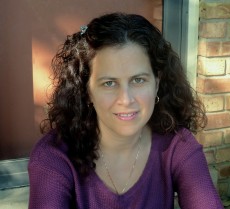A faculty member you should know: Gizella Meneses
 Gizella Meneses
Gizella Meneses
Noir? Neo-noir? “You’ll know it when you see it,” Associate Professor of Spanish Gizella Meneses said about film noir. Though the exact definition may be debatable, Meneses found a way to enter the conversation by looking specifically at Argentine noir and neo-noir in her first book.
“If I gave you a series of films, you would recognize the noir characteristics: low-key lighting, chiaroscuro effects, distorted camera angles, asymmetrical compositions, and obscured faces,” she said. “But the real point of our book is that noir is not just a Hollywood phenomenon—it’s an international one.”
Meneses will discuss her book, Argentine Cinema: From Noir to Neo-Noir, which she co-authored with David George, professor of Spanish and Portuguese, emeritus, at 4 p.m. on Thursday in room 221 of the Donnelly and Lee Library.
Meneses, who teaches a range of Spanish courses focusing on topics from literature to crime fiction and film, is a faculty member you should know.
Q: What is your area of study?
A: “My area of study has shifted. For a while, it was testimonial literature and indigenous literature. I then shifted to Latinx studies—I have a couple of short documentary films I’ve completed along with an article and a few creative pieces I’ve written in that area. My subfield during my doctoral program was in the humanities and film where I examined the study, the theory, and the history. David George, my colleague who co-authored the book with me, is also a cinephile and we both taught film on campus before he retired. Since I was already working in film, the next step was to work on this book with David, so now I am more focused on film studies and Latin American film specifically.”
Q: What is noir?
A: “Noir, of course, means ‘black,’ and this is reflected in certain characteristics of this film genre, such as low-key lighting and night-for-night shots, especially in classic noir. The classic noir period was the 1940s and 1950s, so anything after 1959 is considered neo-noir. Scholars, reviewers, and film buffs argue endlessly over definitions of film noir and neo-noir. Most would agree that films noir are crime thrillers but not all crime thrillers are noir. Yet there is wide disagreement regarding classifications: is noir a style, a mood, a movement, a genre, or a discourse?”
Q: Why did you decide to write this book?
A: “We noticed that there wasn’t much written on noir, especially on Latin American noir. We probably found every article ever written on Argentine noir, and there weren’t many, or there were books on the history of Argentine cinema that contained a chapter on noir. We figured this was fertile territory.”
Q: What is the focus of your book?
A: “We discuss the history of noir, especially in the introduction, but our chapters are divided into films. We have one film from the classic noir period, which is Naked Angel, and from there we move on. We have a fairly large introduction, not just to noir but Argentine noir specifically. To differentiate our book, we studied classic noir, neo-noir, and retro neo-noir. Lastly, we discuss the craft of noir.”
Q: How has your book been received?
A: “I recently returned from a conference in Ecuador, and the topic is quite relevant. There was a lot of interest in the book, which is exciting. We even had someone cite us on one of the conference panels. So we hope that means our book will generate some interest. We’re already discussing our next book. Maybe Mexican noir? We’re looking ahead since it’s been an exciting project for us.”
— Tracy Koenn ’18
